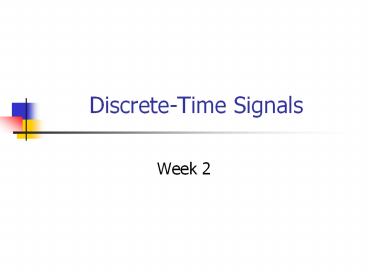Discrete-Time Signals - PowerPoint PPT Presentation
1 / 14
Title:
Discrete-Time Signals
Description:
Discrete-Time Signals Week 2 Continuous-Time Versus Discrete-Time Signals Continuous-time signal: a signal defined by a function of a continuous-time variable. – PowerPoint PPT presentation
Number of Views:126
Avg rating:3.0/5.0
Title: Discrete-Time Signals
1
Discrete-Time Signals
- Week 2
2
Continuous-Time Versus Discrete-Time Signals
- Continuous-time signal a signal defined by a
function of a continuous-time variable. - Discrete-time Signal a signal defined by
specifying the value of the signal only at
discrete times, called sampling instants.
3
Continuous-Time Versus Discrete-Time Signals
4
Distinction between Discrete-Time and Quantized
Signals
- Quantized Signal A quantized signal is one whose
values may assume only a countable number of
values, or levels, but the changes from level to
level may occur at any time.
5
Periodic and Aperiodic Signals
- Periodic a signal x(t) is periodic if and only
if - x(tT0)x(t), -?lttlt? (1)
- where the constant T0 is the period.
- Aperiodic Any deterministic signal not
satisfying (1) is called aperiodic.
6
Periodic Signals
7
Aperiodic Signals
8
Some Elementary Discrete- Time Signals
- Unit sample
- Unit step
9
Some Elementary Discrete- Time Signals
- Exponential sequence
- Sinusoidal sequence
10
Some Elementary Discrete-Time Signals
(2) Unit step
(1) Unit sample
(3) Exponential sequence
(4) Sinusoidal sequence
11
Energy and Power Signals
- Total energy
- Average power
- X(t) is an energy signal if and only if 0ltElt?, so
that P0. - X(t) is an power signal if and only if 0ltPlt?,
thus implying that E?. - Signals that satisfy neither property are
therefore neither energy nor power signals.
12
Addition, Multiplication, and Scaling
- Addition
- Multiplication
- Scaling
13
Convolution of Two Discrete- Time Signals
- Convolution
- Properties
- 1. Commutative property
- 2. Associative property
- 3. Distributive property
14
Correlation of Two Discrete- Time Signals
- Cross-correlation function
- Autocorrelation function
- p0 maximum































